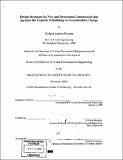Design strategies for new and renovation construction that increase the capacity of buildings to accommodate change
Author(s)
Keymer, Michael Andrew, 1976-
DownloadFull printable version (23.05Mb)
Other Contributors
Massachusetts Institute of Technology. Dept. of Civil and Environmental Engineering.
Advisor
E. Sarah Slaughter.
Terms of use
Metadata
Show full item recordAbstract
An analytical framework is developed for examining the critical characteristics of design strategies for new and renovation construction that increase the capacity of buildings to accommodate change, and for selecting appropriate design strategies for particular projects. Unlike previous building studies, this research explicitly takes into account the interactions within and between building systems and subsystems that affect the capacity of the building to accommodate change. A sample of 37 unique design strategies is identified through interviews with construction industry professionals and a review of recent literature. All design strategies and data are empirically derived and have been used in one or more buildings throughout the world. The achievements of design strategies are compared to the needs of users, to identify strategies that successfully fulfill the building user's needs over time. These achievements and needs are consistently characterized in matrix form, accounting for types of changes expected, enhanced, or enabled, building systems affected, and timeframe of expected changes. Benefits of each design strategy are evaluated over the full life of a building. Strategies with common means of increasing systems' capacities to accommodate change are compared and contrasted. Several strategies are recommended for particular building types, and for three individual case study buildings. Application of the analytical framework provides new insight into the nature of changes needed in different types of facilities, and the variety and applicability of means to achieve those changes. A building designer or facility manager could use this framework to properly select one or more design strategies that would satisfy the needs set forth by an owner for a particular project.
Description
Thesis (S.M.)--Massachusetts Institute of Technology, Dept. of Civil and Environmental Engineering, 2000. Includes bibliographical references (p. 311-315).
Date issued
2000Department
Massachusetts Institute of Technology. Department of Civil and Environmental EngineeringPublisher
Massachusetts Institute of Technology
Keywords
Civil and Environmental Engineering.